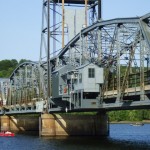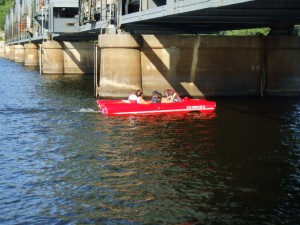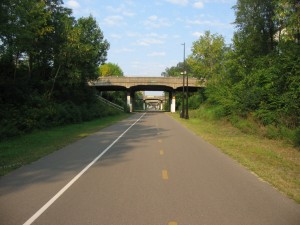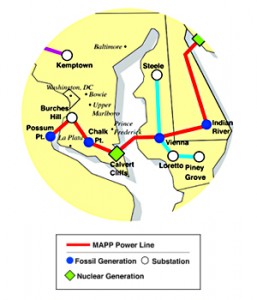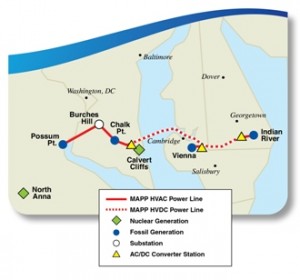NPS: No Stillwater Bridge
October 18th, 2010
Friday the National Park Service said NO to the Stillwater Bridge across the Wild & Scenic St. Croix River.
This is the same NPS, but a different region, that has the Susquehanna-Roseland transmission line crossing of the Wild & Scenic Delaware Water Gap under review.
This Stillwater Bridge mess has been a decades long struggle.
When I heard about this on Friday, I started looking for the primary documentation, and couldn’t even find a press release. Then this a.m., a little birdie sent the press release…
… but alas, he had no primary documentation either! And so onward with the search, and still nothing, then, lo, another birdie dropped these into my inbox:
National Park Service – Transmittal Letter
National Park Service – Stillwater Bridge – Section 7a Review Final
Is there a trend? We can only hope…
PJM shell game continues
October 14th, 2010
This week, PJM has “decided” that part of the humongous 500kV buildout isn’t necessary. Well DUH, but…
PJM Press Release – PJM Board authorizes $18 billion in transmission upgrades
And so please explain why the headline isn’t “PJM Board cancels 500-kilovolt (kV) line connecting the Branchburg, Roseland and Hudson substations in northern New Jersey.”
From that PJM board meeting, there was a presentation that looks like a corporate-style WAKE UP call:
Meanwhile, I’m trying to find the primary documentation, something with specifics about what was “approved” and what was “removed” and the basis for it… nada… nothing that I can find on the site. Something else irritating is that when I’m looking up documents on the PJM site, I often just get a blank black page, particularly from the TEAC site.
One interesting presentation was about a Market Efficiency Analysis, in 2014 without Mid-Atlantic Power Pathway (MAPP), Potomac-Appalachian Transmission Highline (PATH), Branchburg-Roseland-Hudson and Susquehanna-Roseland, and from then on without the Branchburg, Roseland and Hudson line:
2010 Market Efficiency Analysis Results Updates – October 6, 2010
And when I try to get closer to the Northern NJ documentation… well, tell me if YOU can get anything:
“File is damaged and could not be repaired.” So I called the number on the PJM press release to see… and was told they’ll call back. Yes, we shall see…
ALJ: Underground Hiawatha Project
October 9th, 2010
Underground Xcel’s Hiawatha Project transmission. That’s BIG, it’s good news, except for one thing — “Who pays?” is still a question:
ALJ Heydinger’s Recommendation for Xcel’s Hiawatha Transmission Project
Problem is, cost allocation isn’t dealt with specifically, only explained, so no recommendation regarding that.
If the PUC went ahead, would it be spread across the Metro area, the full Xcel rate base, or???
For the SE Metro, and for the Chisago Transmission Project, if they cities would have agreed to shoulder the cost, undergrounding was no problem. But that’s not feasible for a city to pay. So now what? Will the PUC actually order undergrounding, with a broad rate base recovery?
MAPP delayed again… of course!
October 7th, 2010
MAPP then… and MAPP now:
Good news on the Mid-Atlantic Power Pathway front — another continuance granted!
This Order gives the parties until November 30, 2010 to report in on whether a Status Conference is necessary.
Mid-Atlantic Power Pathway is a 500kV transmission line proposed for Maryland and Delaware (the New Jersey part has gone the way of the brontosaurus. Apparently there’s a delay in the Application (well of course, delay’s appropriate and expected when something isn’t needed!). A little birdie told me that Pepco Holdings (PHI) will probably file their updated Application for the Maryland CPCN in November, if PJM gets their act together. The part in Maryland is a revised southern Maryland segment, the undergrounded Bay crossing and the eastern shore to the Delaware state line.
A significant part of this line will be undergrounded.
UMTDI Transmission coming soon?!?!?!
September 30th, 2010
But wait… it’s already here!
Just in from Bob Cupit, from the Upper Midwest Transmission Development Initiative:
Here’s the initial idea:
The RGOS first-mover subset located within the UMTDI states’ footprint is:
• Big Stone, SD to Brookings, SD 345kV – estimated cost of $150 million.
• Brookings, SD to Twin Cities, MN 345kV – estimated cost of $700 million.
• Lakefield Junction, MN to Mitchell County, IA operated at 345kV but constructed at 765kV specifications to allow full upgrading and operation at 765kV in the future – estimated cost of $600 million.
• North La Crosse, WI to North Madison, WI and Dubuque, IA to Spring Green, WI to Cardinal, WI 345kV – estimated cost of $811 million.
• Sheldon, IA to Webster, IA to Hazleton, IA 345kV – estimated cost of $458 million.
In addition to the proposed transmission projects above, the Midwest ISO’s Midwest Transmission Expansion Plan (MTEP) for 2011 identifies the following transmission project as an initial candidate for regional cost sharing because of its regional benefits.
• Ellendale, ND to Big Stone, SD 345 kV – estimated cost of $275 million.
OK, folks, do any of these lines look familiar? Why is the CapX 2020 Brookings SD to Twin Cities MN 345kV line on this list? Why is the CapX/ATC North LaCrosse, WI to North Madison, WI on this list? Hmmmmmmmmmm…yet they say this:
Although UMTDI actively engaged in the identification of possible renewable resource areas and potential transmission corridors, this should not be taken as expression of support for particular routes, particular projects, particular voltages, or appropriate levels of spending in any state proceeding. Those decisions remain for a future day, when specific projects might be proposed. However, the Executive Committee sees great value in affirming its support for coordinated state efforts on these multi-state projects, and its general support for these corridors, which appear to have value in all identified reasonable futures.
Um… hello, they’re listing specific proposed projects.
Of course it’s all connected, how stupid do they think we are? Well, pretty damn stupid, look what they’re recommending, cost-sharing to shift the cost across MISO:
A key, unresolved issue for construction of projects of this magnitude is cost sharing. The criteria in the Midwest ISO’s recent tariff filing at FERC, as well as other activities ongoing at the Midwest ISO, indicate that these first-mover projects would likely all qualify for cost allocation treatment. This designation would mean that all energy users in the Midwest ISO’s footprint would share the costs of these “no regrets” lines. FERC has not approved this rate treatment, however, and it is likely that FERC will receive a number of comments and objections to the Midwest ISO’s tariff proposal. While the UMTDI Executive Committee has not taken a position on the Midwest ISO’s cost allocation filing, it is safe to say that the absence of cost sharing would make construction of EHV transmission lines in these corridors very difficult.
And PJM too:
The total cost for these first-mover lines is approximately $5.8 billion with $1.4 billion being funded by customers in PJM, the Midwest ISO’s neighboring independent system operator to the east.
And because they know this isn’t needed or wanted, they’re frantically trying to find a way to circumvent state authority — how about a multi-state regulatory body to site transmission… or direction to the states from FERC to act:
States Together
Interstate Compacts At the highest levels, all five states have the power to create a compact, with the consent of Congress, to establish a common agreement on how to develop the UMTDI Project. Minnesota and Wisconsin provide specific powers to their respective governors to enter compacts involving transmission lines. Congress has specifically contemplated the compact mechanism by authorizing three or more states to form a compact, subject to Congressional approval to “facilitate siting of future electric energy transmission facilities.” Sec. 216(i) of the Federal Power Act (FPA), 16 U.S.C. § 824p. Another FPA provision, little used § 209, authorizes the FERC to delegate any subject matter in its jurisdiction to a group of states, offering another potential avenue of federal approval for joint state action on transmission siting and cost allocation.
…”little used § 209″… how perverted can we get? Perhaps there’s a reason why a state PUC would be reluctant to permit projects like this?!?!?!?

